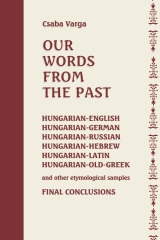|

An etymological comparison of word-samples
out of 13 different
languages.
https://www.createspace.com/3482003
“And the whole earth was of one language
and of one speech” (Genesis
I.11.1)
Where and when did this one language develop?
What kind of language was it?
Is it still around?
Supposedly we found it – what’s the proof of it
being the mother of all languages?
We will find the answers for all these questions
by reading this book and following
the
author’s sharp logic.
1. Introduction
The first part of this
book contains introductory and informatory messages. The second part
offers etymological comparisons of word-clusters taken from
twelve (+1) different languages with their Hungarian counterparts.
The third part contains the theoretical foundation and conclusion.
The twelve languages are: English, German, Russian,
Ancient-Greek, Etruscan, Latin, Hebrew, Sumerian, Tamil, Mongolian,
Bask, Quechua / Aymara. The words being brought to comparison
are practically identical with the Hungarian equivalents.
The most important criterion by the collection of the word-clusters
was the easy verifiability. I used one dictionary per language (exception
Hebrew), which are available in the book-stores, in the libraries,
on the Internet or standing on the bookshelves everywhere.
The biggest help for this work was the “Etymological Dictionary of
the Hungarian Language” by Czuczor-Fogarasi, published by the
Hungarian Scientific Academy 1862.*
*The dictionary by Czuczor-Fogarasi is a marvellous memorial of the
Hungarian language. Without knowing its etymological principles,
nobody can say that he understands the words in all details. The two
authors’ performance in linguistics can only be measured by that of
Einstein and Newton in Physics. It differs only by the amount of
publicity. The “A magyar nyelv szótára” (The dictionary of the
Hunngarian language) is available per Internet from Arcaneum
adatbázis.
2. The final
conclusion
Should we find that
all word-heaps – collected from several different languages and
containing mostly different words – independently correspond with
different areas of a certain selected language, then we can rightly
conclude that this selected language has been the root or the
starting-base of all languages of which the word-samples were taken
from.
We should call this discovery one of the most important theses of
“Historical Linguistics”. This acts like a wrench, there is no
way out.
Our previous word-comparisons of twelve languages (together over two
thousand Hungarian words and word-building elements) proved our
thesis. The word-samples taken from different languages have few
common features, but they all can be found in the Hungarian language.
Finally, you
find in the appendix the deep-going etymological examination of
two archaic word-roots of the “root-language” |